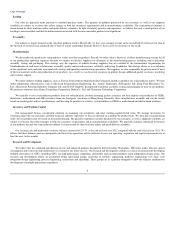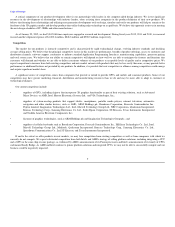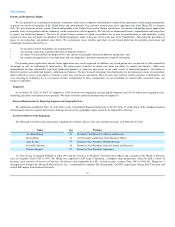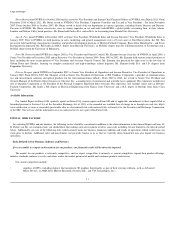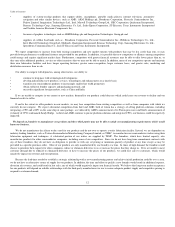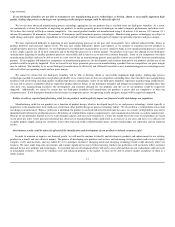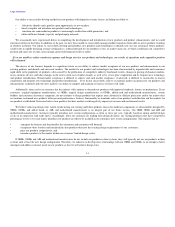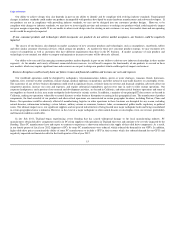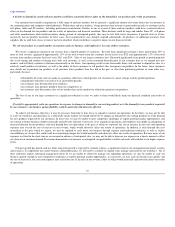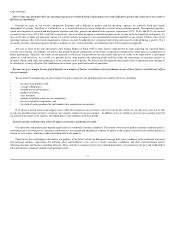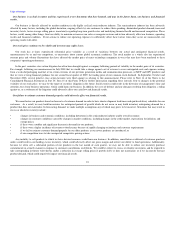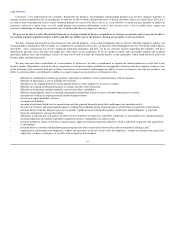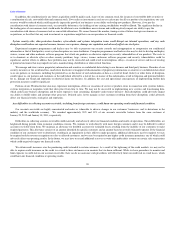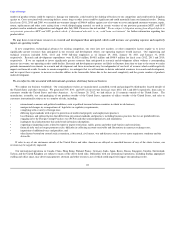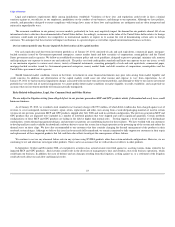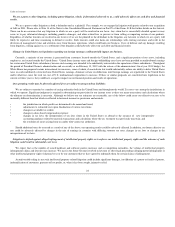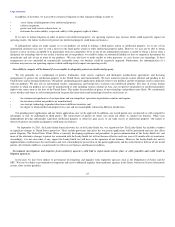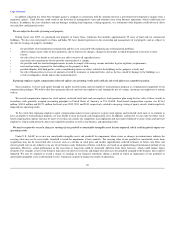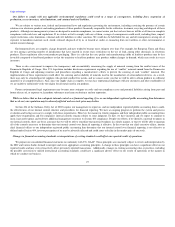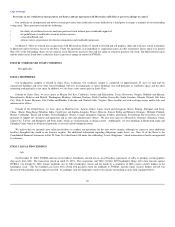NVIDIA 2012 Annual Report Download - page 19
Download and view the complete annual report
Please find page 19 of the 2012 NVIDIA annual report below. You can navigate through the pages in the report by either clicking on the pages listed below, or by using the keyword search tool below to find specific information within the annual report.
Table of Contents
Our business is cyclical in nature and has experienced severe downturns that have harmed, and may in the future harm, our business and financial
results.
Our business is directly affected by market conditions in the highly cyclical semiconductor industry. The semiconductor industry has been adversely
affected by many factors, including the global downturn, ongoing efforts by our customers to reduce their spending, diminished product demand, increased
inventory levels, lower average selling prices, uncertainty regarding long-term growth rates and underlying financial health and increased competition. These
factors, could, among other things, limit our ability to maintain or increase our sales or recognize revenue and in turn adversely affect our business, operating
results and financial condition. If our actions to reduce our operating expenses to sufficiently offset these factors when they occur are unsuccessful, our
operating results will suffer.
Our stock price continues to be volatile and investors may suffer losses.
Our stock has at times experienced substantial price volatility as a result of variations between our actual and anticipated financial results,
announcements by us and our competitors, or uncertainty about current global economic conditions. The stock market as a whole also has experienced
extreme price and volume fluctuations that have affected the market price of many technology companies in ways that may have been unrelated to these
companies' operating performance.
In the past, securities class action litigation has often been brought against a company following periods of volatility in the market price of its securities.
For example, following our announcement in July 2008 that we would take a charge against cost of revenue to cover anticipated costs and expenses arising
from a weak die/packaging material set in certain versions of our previous generation media and communication processor, or MCP and GPU products and
that we were revising financial guidance for our second fiscal quarter of 2009, the trading price of our common stock declined. In September, October and
November 2008, several putative class action lawsuits were filed against us relating to this announcement. Please refer to Note 14 of the Notes to the
Consolidated Financial Statements in Part IV, Item 15 of this Form 10-K for further information regarding these lawsuits. Due to changes in the potential
volatility of our stock price, we may be the target of securities litigation in the future. Such lawsuits could result in the diversion of management's time and
attention away from business operations, which could harm our business. In addition, the costs of defense and any damages resulting from litigation, a ruling
against us, or a settlement of the litigation could adversely affect our cash flow and financial results.
Our failure to estimate customer demand properly could adversely affect our financial results.
We manufacture our products based on forecasts of customer demand in order to have shorter shipment lead times and quicker delivery schedules for our
customers. As a result, we may build inventories for anticipated periods of growth which do not occur or may build inventory anticipating demand for a
product that does not materialize. In forecasting demand, we make multiple assumptions any of which may prove to be incorrect. Situations that may result in
excess or obsolete inventory include:
• changes in business and economic conditions, including downturns in the semiconductor industry and/or overall economy;
• changes in consumer confidence caused by changes in market conditions, including changes in the credit market, expectations for inflation, and
energy prices;
• if there were a sudden and significant decrease in demand for our products;
• if there were a higher incidence of inventory obsolescence because of rapidly changing technology and customer requirements;
• if we fail to estimate customer demand properly for our older products as our newer products are introduced; or
• if our competition were to take unexpected competitive pricing actions.
Any inability to sell products to which we have devoted resources could harm our business. In addition, cancellation or deferral of customer purchase
orders could result in our holding excess inventory, which could adversely affect our gross margin and restrict our ability to fund operations. Additionally,
because we often sell a substantial portion of our products in the last month of each quarter, we may not be able to reduce our inventory purchase
commitments in a timely manner in response to customer cancellations or deferrals. We could be subject to excess or obsolete inventories and be required to
take corresponding inventory write-downs and/or a reduction in average selling prices if growth slows or does not materialize, or if we incorrectly forecast
product demand, which could negatively impact our financial results.
18


